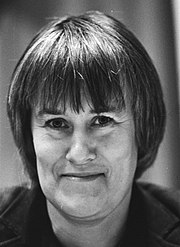Elske ter Veld's Human Design Chart
2/4 Sacral GeneratorDutch politician . She was from 1989 to 1993 for the Labor Party (PvdA), State Secretary for Social Affairs and Employment in the Lubbers III and for many years a member of both the First and the Second Chamber.
Ter Veld visited the elementary school, the gymnasium and the Rijks HBS in Groningen. After that she followed the training as a social worker at the Groningen social academy, the ASCA. After her graduation she worked from 1968 as a working worker working youth in Assen. Later she worked at several club and community centers in Groningen. In 1972 she moved to the trade union. At the NVV (from 1976 FNV ) she succeeded Nel Tegelaar as head of the secretariat for female employees. She would stay that until 1981. Just like Tegelaar, she focused on influencing policy, both within the trade unions and in the Hague circuit. For example, Ter Veld was a member of the Labor Foundation and she was a member of the Emancipation Committee.
Ter Veld was internationally active as chair of the Women’s Committee of the IVVV and the Women’s Labor Committee of the European Trade Union Confederation (ETUC).
She was committed to equal pay, equal opportunities for women, equal rights to pensions. In 1981, Ter Veld became a member of the House of Representatives for the PvdA on 15 September . In the House of Representatives she focused mainly on issues related to social security. She worked closely with PvdA member Thijs Wöltgens . The two were called Thijske, a contraction of Thijs and Elske.
On 7 November 1989 she was appointed Secretary of State for Social Affairs and Employment in the third Lubbers cabinet. During her reign, a law was reached in 1990 on the equal treatment of men and women in the field of supra-statutory social security. The bill was submitted in 1988 by State Secretary De Graaf. In the same year, the Parental Leave Act, which guarantees employees a minimum leave arrangement for the care of young children. The bill was submitted in 1988 by Minister De Koning . Furthermore, Ter Veld was closely involved in the major adjustment of the WAO , on which the government appeared to fall a number of times and about which PvdA leader Kokalmost stumbled. It did not come that far. However, Ter Veld’s actions led to great dissatisfaction in the PvdA faction. In particular, her proposals for a new Dependents Act and curtailing the right to social assistance led to strong criticism in her own ranks. The criticism became so severe that she no longer had the confidence of her group. She returned on June 4, 1993. Shortly after the subsequent press conference – but still in sight of the press – she burst into tears. The photo taken by Bert Verhoeff , supported by party companion Jeltje van Nieuwenhoven, wrote parliamentary history. Afterwards she quoted a pop song about that tragic moment:It’s my party, and I cry if I want to from Lesley Gore .
On 13 June 1995 she became a member of the Dutch Senate for the PvdA , until she retired on 10 June 2003.
Ter Veld was a member of the Committee of Recommendation of the Dutch Social Forum and was chairman of the Association Collaboration of Chronic Respiratory Support.
Ter Veld died after a sickbed in 2017 at the age of 72.
Link to Dutch wikipedia
Discover More Famous People
Browse and analyze over 55,000 public figures and celebrities.
Ra Uru Hu
5/1 Manifestor
Martha Stewart
4/6 Manifestor
David Lynch
4/6 Generator
Barack Obama
6/2 Projector
Steve Jobs
6/3 Generator
Vladimir Putin
5/1 Manifestor
Kim Kardashian
3/5 Generator
Michael Jackson
1/3 Projector
Marilyn Monroe
6/2 Projector
Ariana Grande
2/4 Projector
Oprah Winfrey
2/4 Generator
Johnny Depp
2/4 ManifestorWhat is HumanDesign.ai and how does it work?
Curious what makes Elske ter Veld tick? HumanDesign.ai instantly maps their exact birth data into a fully interactive clickable bodygraph chart, letting you hover or tap every center, channel, and gate for plain-language explanations. Bella, the platform’s built-in AI guide, adds context in real time, translating complex mechanics into everyday insights so you can see how Elske ter Veld’s strengths, challenges, and life themes play out on-screen.
The same tools are waiting for you. Generate your own Human Design Chart in seconds, open a library of 2000+ suggested questions, and chat with Bella as often as you like to decode your design, daily transits, and even relationship dynamics.
Want to compare energies? Save unlimited charts for friends, family, or clients, then ask Bella to reveal compatibilities, composite patterns, or coaching tips, all in one conversation thread.
Start free with core features, or unlock our Personal and Pro plans for deeper dives: unlimited Q&A, celebrity chart search spanning 55,000+ public figures, white-label PDF reports, branded content generation, and a professional profile with built-in booking for practitioners. Whether you’re exploring your own potential or guiding others, HumanDesign.ai delivers an ever-expanding toolbox of AI-powered insights—no spreadsheets, no jargon, just clarity at your fingertips.
Ready to see yours? Signup for FREE today!

